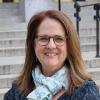
Peter Dwyer of Liturgical Press scrolls through a blog during a discussion between U.S. bishops and Catholics engaged in social media Sunday in Baltimore. (CNS/Nancy Phelan Wiechec)
Catholics, just like the rest of society, are using online social media, but they aren't necessarily going to Catholic sites, according to a newly released study by the Center for Applied Research in the Apostolate at Georgetown University.
The study, "Catholic New Media Use in the United States, 2012" was released Sunday and presented that day during a meeting of U.S. bishops and Catholic bloggers just prior to the bishops' annual fall general assembly in Baltimore.
According to the report, 62 percent of adult U.S. Catholics, representing an estimated 36.2 million people, have a profile on Facebook; that number climbs to 82 percent among Catholics born since 1982. Fifty-eight percent of Catholics age 30 and under post information at least once a week on social media.
Eight percent of adult Catholics who regularly use a digital device said they use at least one Catholic-related application and 5 percent (or 2.9 million people) read or follow blogs on the Catholic church, faith, or spirituality. Among weekly Mass attenders, 13 percent read or follow blogs on the church primarily to learn more about the church's teachings and their faith and to stay up to date on news of the church.
The report also shows that adult Catholics are evenly divided in their awareness of the Catholic church's online presence. Twenty-four percent said the church was "somewhat" or "very" visible, while 23 percent said it was "only a little" or "not very" visible. Fifty-three percent of Catholics were unaware of any significant online Catholic presence.
The Catholic website most often visited regularly by adult Catholics is their parish website, which about one in 10, or 9 percent, say they visit once a month or more.
Respondents also cited three top concerns about the Catholic church's presence online: lack of a system for the church "to validate sites and content as authentically Catholic," 45 percent; lack of a civil tone in conversations taking place on the Internet, 43 percent; and a reluctance by Catholic leaders to use the Internet, 42 percent.
About a third agreed "somewhat" or "strongly" that they want their pastor to blog, 33 percent, and their bishop to blog, 31 percent.
The survey, of 1,047 Catholics from Sept. 10-18, was commissioned by the U.S. Conference of Catholic Bishops' Department of Communications. Eighty-four percent of respondents took the survey in English; 16 percent took it in Spanish. The margin of error for the survey is plus or minus 3 percentage points.
Mark Gray, director of Catholic polls and a research associate at CARA, who presented the survey's results to bishops and bloggers, said the results pose the challenge of how to reach more Catholics online.
He said he was surprised that Catholics searching online say they are mainly looking for information about the church history and the saints. Gray said the key is to draw these viewers in, provide the information they want, and also entertain them.
Mary DeTurris Poust, a panelist at the session for Catholic bloggers and bishops and author of the blog, "Not Strictly Spiritual," said the report didn't surprise her. She also said the idea that online viewers want to be entertained is "not something to push aside."
She said Catholic websites must be up to date. "They have to evolve and maybe even be edgy and entertaining" or viewers will not be drawn in or certainly will not stay.
Another panelist at the bloggers' session was Auxiliary Bishop Christopher J. Coyne of Indianapolis, who is no stranger to social media. His Twitter feed has about 4,000 followers and he writes a blog and does podcasts.
The bishop said he is active with social media to "proclaim salvation."
As he put it: His tweets, blog entries and podcasts are attempts at "planting seeds and letting them grow where they will."
He didn't negate the finding that a small number of Catholics visit Catholic websites, stressing that even if he reaches 1 percent of Catholics in one week that's still a lot of people.
Coyne said he tries to use humor online and aims to follow the example of St. Augustine who emphasized the need to teach, please and persuade in communication.



